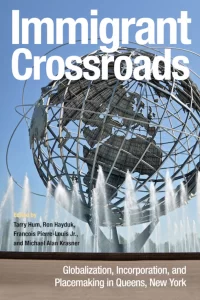Book Chapter on Participatory Budgeting in Immigration Crossroads: Globalization, Incorporation, and Placemaking in Queens, New York

As a research associate with the Center for Immigration Studies, I worked with immigrant-based community organizations in Queens, NY to investigate experiences and perspectives of NYC’s participatory budgeting process. Focus groups with organization members undergirded the creation and analysis of a survey that was disseminated through community organizations. The work was published in a two collections – one, a special issue on the state of participatory budgeting in Queens, alongside pieces from the Participatory Budgeting Project (PBP) and the Urban Justice Center, and a second, a book titled “Immigrant Crossroads: Globalization, Incorporation, and Placemaking in Queens.”
Below is a review of the book that includes the book chapter.
Suggested Citiation: Hayduk, R., Tomashiro Folla, D, and Hackett, K. (2021). “Forging Immigrant Political Engagement: Participatory Budgeting in Queens”. In Immigrant Crossroads: Globalization, Incorporation, and Place-Making in Queens, NY, edited by Tarry Hum, Ronald Hayduk, Francois Pierre-Louis and Michael Krasner. Temple University Press.
Review of Immigration Crossroads: Globalization, Incorporation, and Placemaking in Queens, New York
Book edited by Tarry Hum, Ron Hayduk, Francois Pierre-Louis Jr., and Michael Alan Krasner Temple University Press 392 pages • $42.95
Review By Sheryl-Ann Simpson for Progressive City
In the introduction to Immigrant Crossroads, co-editor Tarry Hum outlines that forty-eight percent of the 2.3 million residents of the Queens borough of New York City are foreign born, arriving from around the globe, rather than there being one dominant group. In the preface, the editors describe Queens as “certainly the most diverse community in the United States, probably the most diverse community in the world today” (vii). As someone from Toronto, I might quibble with the second part of the statement, but there’s no disputing the unique make-up of the population in Queens which makes it an important context for understanding how experiences of immigration, settlement and urban development are changing.
As Hum explains, the book sets out to understand the diversity of immigrant experiences in the borough through processes of racialization particularly related to the post-1965 experience and to place. So, the book takes the city as not just as a neutral background to immigration but aims to understand the ways in which the urban context, economic and political institutions, influence the experience and identity of immigrant residents. And it asks how immigrant communities are integrating into and influencing these institutions in return.
The book is a data-rich exploration of New York City’s Queens borough. And to be clear, data doesn’t just mean numbers. While the chapters are filled with a fair amount of tables, charts and maps, there are equally vibrant descriptions, historical narratives and organizing stories throughout that bring the borough to life. It’s the detailed exploration of Queens that helps the book overcome what I’d describe as the ‘New-York problem’, or more generally, the problem that pops up when we base all of our planning and urban theory on global cities. The authors’ attention to detail, focus on process and clear engagement with, and attachment to Queens pulls the borough off the map—to borrow a phrase from Jennifer Robinson. By featuring Queens and immigrant communities in such detail, the book becomes a useful tool to understand the place, and for comparison and inspiration rather than a blueprint for how development should happen elsewhere.
…